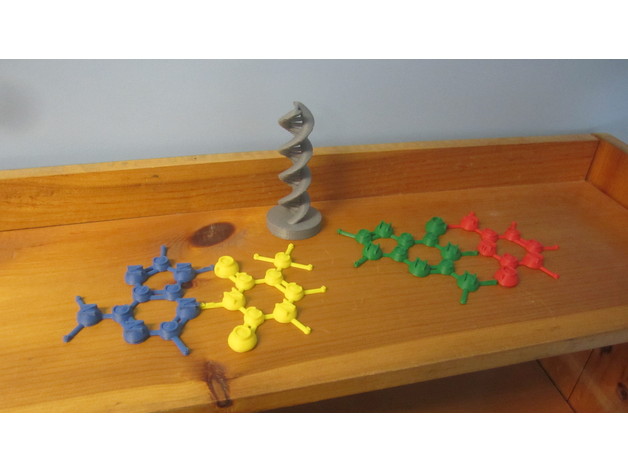
DNA Helix and Nucleotides
thingiverse
The intended use of our model is to provide a detailed visual representation of DNA's inner workings and structure within the Helix and Nucleotides. By doing so, we aim to demonstrate the mathematical concepts behind these structures as well as their shapes and areas. Furthermore, we seek to showcase the different scaling processes used to accurately represent each atom and bond, thus highlighting various size components in comparison to one another. Moreover, with DNA, numerous ways exist to alter and manipulate chromosomes as well as bonds to create mutations. We intend to explore the probability aspect of creating infinitely many mutations based on mixing up bonds and changing different pairs of chromosomes, splicing, and so forth. We plan to incorporate a real-life example, such as scientific DNA, and explain how its principles and structure relate to the field of Mathematics. Various Google images inspired our design process in producing the four distinct nucleotide structures. Print Settings Printer Brand: SeeMeCNC Printer: Rostock MAX Notes: The models in the photos were scaled up prior to printing: the helix was scaled by 500% and the nucleotides were scaled by 250%. All were printed with a 0.5mm diameter nozzle. Post-Printing Assembling Instructions For this model, assembling is relatively straightforward. The primary task involves pairing the four Nucleotides, where Adenine bonds with Thymine, and cytosine bonds with guanine. The bonding sites are marked with "I", "II", and "III". How I Designed This This project required a significant amount of work and time to perfect it. For the Helix, we created a wide cylindrical base as support for the helix model. We then stretched the helix to spiral around 4-5 times. With the helix, we connected 23 lines using polar-caps cylinders to represent each pair of chromosomes, ensuring that each end is capped to give it a cylindrical shape and structure. For the nucleotides, we produced four different types: Adenine, Thymine, Guanine, and Cytosine. Each type has unique structures yet shares similarities. We used hexagons inscribed in circles to achieve the desired shape design. The cylinders represent the bonds between atoms, with radii varying from 0.25mm to 0.8mm for our final print. Spheres are used to represent specific atoms, and each sphere's size is representative of the number of protons in its nucleus (ignoring neutrons). We also engraved the atomic symbol on top of the sphere to indicate which element it represents. To make the nucleotides more compact and thicker for printing purposes, we scaled up different elements. By slicing the model in half, we were able to have the spheres flat against the print bed, ensuring effective printing. Mathematical Problems and Questions Some challenges we encountered during our design process include having small details appear on our first print jobs. We also struggled with scaling accuracy and precision for each atom. Rhino sometimes did not cooperate as desired, and finding the bonding sites of where atoms bonded was a challenge that required accuracy. Organizing different sizes and angle measurements to make the nucleotides functionally printable proved difficult. Some mathematical questions arose during the design process, including concerns about the 23 pairs of chromosomes and their area. We also explored similar lengths and areas of cross-sections as well as space between them, along with angle similarities between bonds and atoms. Signature: Ryan, Matt
With this file you will be able to print DNA Helix and Nucleotides with your 3D printer. Click on the button and save the file on your computer to work, edit or customize your design. You can also find more 3D designs for printers on DNA Helix and Nucleotides.
